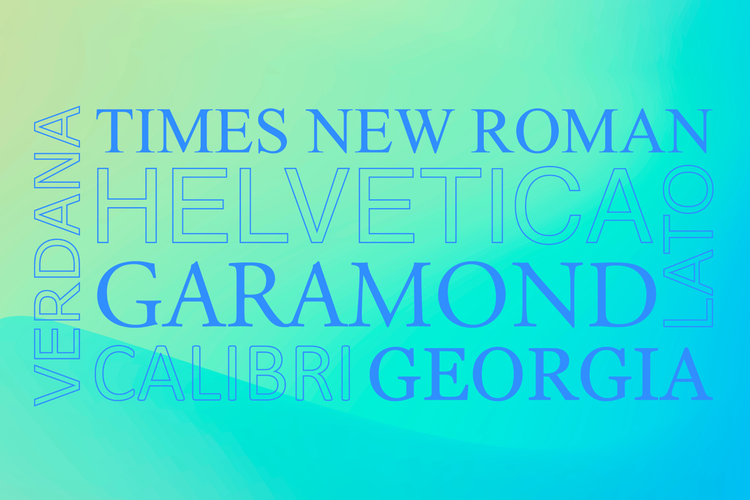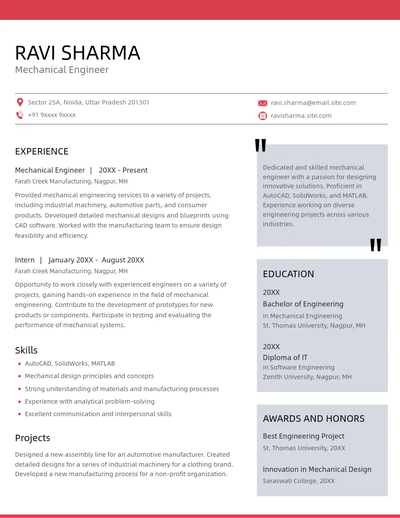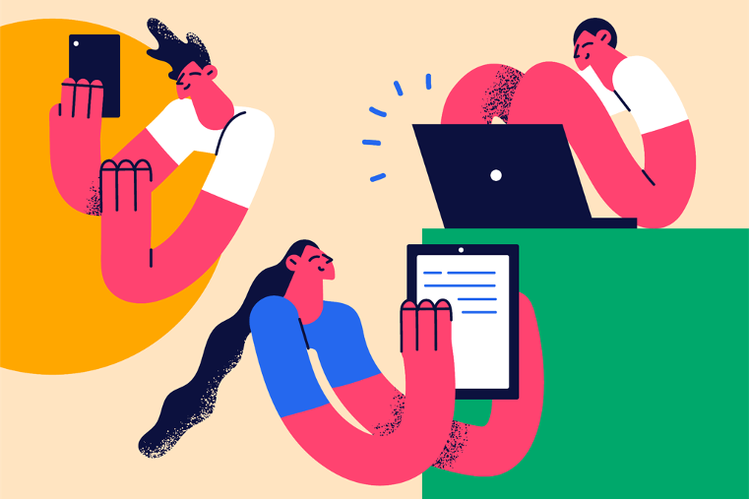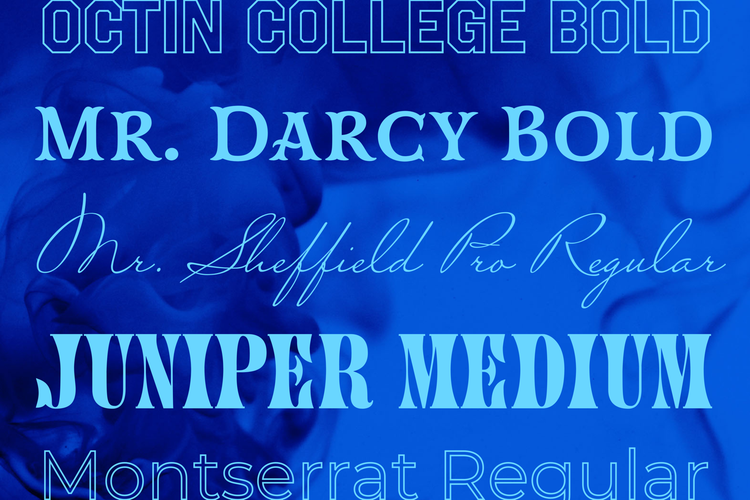It is important to pay attention to the font you select beyond simply making sure it is legible and professional. Carefully selecting a font that not only looks good but also reflects your personal brand can help employers recognize your unique style and attributes, making your resume stand out from the pack.
Best resume font examples
Calibri
Calibri is a modern sans-serif typeface. You might recognize it as being the default font in Microsoft Word. It was designed to be legible on screen and easily readable at a variety of sizes and resolutions. Its clean lines and balanced proportions make it an ideal choice for digital displays, documents, and web pages. Additionally, its friendly appearance makes it a great choice for a resume.
Calibri is a popular font choice for resumes, with good reason. It is a clean and simple sans-serif typeface, meaning it has no extra decoration or embellishments. This not only makes it easy to read, it also helps employers to quickly scan your resume. Furthermore, Calibri is versatile enough to work with many other fonts and formatting options you may choose for your CV and reference list.
Calibri is a modern and professional font choice for job seekers. Its neutral sans-serif style makes it appropriate for most applications, as it conveys a sense of professionalism and trustworthiness. Calibri's subtle elegance makes it an attractive typeface for job hunters seeking to make a strong impression on employers.
Arial
Arial is one of the most popular and widely used fonts for professional documents like resumes. Its simple, clean lines and easy-to-read sans-serif style make it a great choice for job seekers looking to create an attractive, organized resume. Its neutrality also makes it an ideal font for most applications.
This sans-serif style makes it easy to read on screen and in print, while still giving documents a professional appearance. Its rounded corners and subtle curves make it a great choice for job seekers looking to add a hint of sophistication to their applications.
Arial is an ideal font to use for all kinds of resumes because it is legible, highly versatile, and widely available. This typeface offers maximum flexibility when creating a professional-looking document and stands out against the more traditional fonts like Times New Roman. Arial can be used in a variety of sizes and styles, making it perfect for any section of the resume including headings, main body text, and summaries. It also looks sharp when printed or sent as an electronic document. The clean lines make information easier to read while maintaining integrity in the overall presentation. For job hunters looking to make a good impression, Arial is an appropriate font choice.
Cambria
Cambria is a typeface designed to make reading on screens easier and more enjoyable. It features large x-height, open letterforms with low contrast, and generous spacing between letters. This sans-serif font's wide proportions create a strong readability that makes it suitable for both digital and print resumes. In addition, Cambria features a variety of weights, allowing you to express different tones in your resume.
The low contrast between characters helps create a calm and inviting atmosphere, making it perfect for branding. Cambria's bold character shapes give it a distinctive look that can be used to convey authority, classiness, and modernity. This typeface has a classic yet modern feel to it, which can help create an attractive and effective presentation of your information no matter the font size. Whether you need to express authority and seriousness or warmth and personality, Cambria is a great choice.
Times New Roman
Times New Roman is a serif typeface which has been used by publishers and writers since the 1930s. The clean lines and sharp strokes of Times New Roman make it especially appealing for long texts, like novels and newspapers. This font is also popular for use in print media because it stands out from other fonts.
Serif typefaces have been used for centuries, and the subtle flourish of Times New Roman helps to give documents a classic feel. It is a standard font on most computer systems today, making it easy to access when needed. Its classic, traditional look conveys an air of sophistication and professionalism, making it the perfect choice for resumes, cover letters, and other important documents. Additionally, its familiarity and ease of use make it an ideal choice for those who need to quickly create a professional document.
Garamond
Garamond is a classic serif font that has been around since the 16th century. It was designed by Claude Garamond, a French type designer and punchcutter, and is known for its readability and gracefulness. The letters have a slightly slanted look to them which adds to its elegant appearance. Its sharp edges help it stand out from other fonts making it great for use in headlines or titles. Its popularity continues today as many digital versions of Garamond can be found on the web and used for various design projects.
Garamond is traditional in appearance, yet has an informal feel. The unique strokes of Garamond give it a subtle flair that stands out from more modern typefaces. This typeface is legible even at smaller sizes, making it a great choice for long documents like books and magazines. Additionally, the curves of this font give it a sense of warmth that creates an inviting atmosphere for readers.
Garamond is an excellent choice for all job hunters who are looking to make a great first impression. Its grace and readability make it suitable for use on resumes, cover letters, and other documents used in job applications. Its classic style gives a sense of sophistication that can help job seekers stand out from the competition.
Trebuchet MS
Trebuchet MS is a graceful sans-serif font. This typeface has an elegant look that stands out from more traditional serif fonts like Times New Roman. The curves and lines of Trebuchet MS give it a modern yet subtle flair that makes it accessible to readers.
Trebuchet MS is a sharp and eye-catching font that works particularly well for headers. The bold strokes of this font give it an authoritative and modern look, making it stand apart from other typefaces. The well-balanced letterforms ensure that the font remains legible even at smaller sizes, which makes it ideal for headlines and titles that need to be both attractive and readable. Plus, its sharp edges create an engaging contrast with softer serif fonts, making Trebuchet MS a great choice for adding emphasis to any document.
Trebuchet MS is an ideal font choice for resumes in creative fields such as design, social media, and marketing. Its boldness helps it stand out, ensuring that your resume will make a great first impression with potential employers.
Book Antiqua
Book Antiqua is a classic serif font with wide letterforms. Originally designed by Monotype Corporation in 1937, the typeface has maintained its traditional look and feel ever since. Its heavy strokes and generous x-heights give it a strong presence, making it ideal for formal documents and logos. The bold weight is even more dramatic, making it an attractive choice for headlines.
Book Antiqua offers more options for a resume than Times New Roman. This font has a range of weights and italicizations, as well as a wide variety of ligatures, so you can customize it to make a statement about your qualifications. Additionally, Book Antiqua was optimized for the web, meaning its characters remain sharp even when resized on digital devices. All in all, this makes Book Antiqua an ideal choice for anyone looking for a modern and eye-catching font that won't lose any clarity or visual impact when viewed on different screens.
Book Antiqua is an excellent choice for job hunters in creative roles due to its classic-yet-modern look. It can be especially helpful when applying for creative positions as employers are looking for individuals who are able to present their skills in a bold manner. Not only does Book Antiqua offer a timeless appearance of sophistication, but its wide letters also allow you to effectively emphasize crucial information while highlighting each section of your resume or portfolio. With this font's traditional look combined with up-to-date design capabilities, Book Antiqua is bound to create an impactful impression on any employer.
For job seekers looking for a traditional role, Book Antiqua is an excellent choice. Its wide letters and classic serif style offer a timeless aesthetic that conveys professionalism and sophistication. But its bold appearance also helps emphasize important words and phrases, making sure your resume stands out from other candidates with more traditional resumes. With Book Antiqua, you can be sure that your application will be noticed and make an impression — perfect for anyone looking to stand out while still remaining professional.
Arial Narrow
Arial Narrow is a version of the popular Arial font that was designed for narrow spaces. This typeface has a simple, modern look that maintains the same proportions as the full-width Arial font. It features all the same characters, glyphs, and accents, allowing it to be used in place of regular Arial while keeping text within a tighter margin.
Despite its narrower width, Arial Narrow retains its sharpness and legibility even at small sizes. It is also available in italic form, giving designers even more options for creating attractive layouts in limited space.
Arial Narrow is the perfect choice for resumes that need to fit into tight spaces. Its condensed letterforms allow it to take up less space than regular Arial while still maintaining a clear and legible font size. This makes it easier to fit more information into the same area, allowing someone's resume to be seen in its entirety without having to shrink the font size excessively.
Georgia
Georgia is a great font choice if you are looking for a professional yet modern look on your resume. In fact, this is the chosen font for LinkedIn. Its thick serif letterforms give off an authoritative and confident feel, while its rounded edges add a touch of warmth to the text. Georgia also has excellent readability, making it easy for potential employers to quickly scan through it. Additionally, the font supports a wide range of languages and offers multiple weights for more advanced typography.
Georgia is a great choice for resumes because it is bold enough to draw attention to important information while still appearing professional and straightforward. It also looks great when printed, making it an excellent option for paper resumes as well as digital ones.
Helvetica
Helvetica is a classic font choice for resumes and other professional documents — think the New York Times. Its clean and modern aesthetic makes it a versatile typeface for any situation, and its wide availability ensures that it can easily be found on most computer systems. However, the same properties that make it so versatile also mean that it can be seen as generic or uninspired, depending on how it's used.
To ensure your resume stands out from the crowd, use Helvetica in combination with other fonts to create an attractive page design. Consider using bold or italicized versions of the font to add emphasis to key points. Additionally, adding subtle touches, like drop shadows or larger text sizes, can further personalize your resume and make it look more engaging to viewers.
Verdana
Verdana is a great font choice for resumes because of its simple, professional look. It has a clean, modern style that conveys confidence and authority while also being easy to read. Its letterforms are slightly wider than other sans-serif fonts, which can make text stand out more in certain contexts.
In addition, Verdana is available in multiple weights so you have the freedom to create an attractive page design with subtle touches, such as bold or italicized versions of the font. However, its relatively low contrast means that some of the finer details like headings and accents may not be as prominent as in other fonts.
For a more distinct look, combine Verdana with another font to create an eye-catching design.
Be organized and concise
When it comes to creating an effective resume, organization and concision are key. To make your resume organized, start by using a consistent format and structure throughout, including the same font, font size, margins, and line spacing for each section. This uniformity will help draw attention to the essential information rather than distract from it.
Resumes should generally be kept to one page in length. This is not only important for providing a concise summary of your skills and experience, but also for helping to draw attention to the key points that you want employers to take note of. By sticking to one page, you can ensure that recruiters will be able to quickly assess your qualifications without getting bogged down in irrelevant or unnecessary information. Furthermore, most employers may discard overly long resumes without reading them.
When making a resume, it is essential to make sure each statement is brief and clear. Each sentence should communicate one idea or skill clearly and concisely. Avoid using prolonged descriptions or vague phrases; instead use short, action-oriented words that succinctly sum up your qualifications.
Focus on using language with higher semantic richness, such as precise terms and engaging adjectives. This will emphasize your accomplishments by making them sound even more impressive.
Finally, make sure that each section is organized in a logical order and that there’s a clear flow throughout the document.
Describe your qualifications
Throughout your resume, avoid using first-person statements. Using the pronoun “I” can come off as self-absorbed or overly opinionated; instead of speaking about your own accomplishments, focus on how you can benefit a potential employer.
Be sure to use passive voice and objective language throughout. Rather than saying “I did this project…” try replacing “this project” with its name or describing what was achieved through it — highlighting results over process.
By avoiding subjective words like “I think/believe/feel etc.,” and sticking to facts and figures that prove your skill set and experience level, you will provide employers with an accurate description of yourself while demonstrating that you are capable of professional communication without being too forward or boastful.
Choose the right voice
It's important to use the correct tense when describing your work experience. For past jobs, you should use past tense wording such as “managed” or “developed," while for present and ongoing positions, you should opt for present tense words like "manage" or "develop."
This will help to create an organized timeline of your career history and make it easier for potential employers to quickly identify what position or positions you currently hold. Careful attention to grammar and word choice keeps resumes professional-looking while providing clarity on your qualifications and experience level.
Punctuate your resume
Paying attention to punctuation is key. Keeping a consistent style of punctuation will help maintain clarity and readability, thus making your resume easier for recruiters to understand and process.
Having the same level of punctuation throughout the document creates a more polished impression; this may not seem like much, but it can make a difference in the eyes of recruiters. As such, use commas, periods, and other similar marks appropriately and with consistency so that employers and recruiters are able to quickly recognize the points you're trying to make on your resume.
Keep sections clear
Breaking up sections and organizing information on your resume plays a major role in making it easier for recruiters to quickly read and understand. Bold, italicize, and underline consistently throughout each section to make sure that the hierarchy of your document is clear and easy to identify. Utilize white spaces to separate and highlight information. For example, you might use italics for job titles, bold for main responsibilities or points, and underlining for section headings.
You can also break up your subsections into bullet points or column lists to provide further structure for the employer when reading your resume. Doing this makes it easier for them to distinguish between different topics within a certain section so they don’t get lost as they’re scanning through your background.
Create flow within the resume
When designing your resume format, it is important to make sure that each section flows logically and clearly from one point to the next. To do this, break up the content into manageable chunks and avoid long paragraphs where possible. Use headings and subheadings to separate sections, as well as bullet points to list relevant qualifications. These techniques will also help recruiters quickly identify what they need to pay attention to in your resume.
Finally, make sure that each section is organized in a logical order and avoid using excessive font styles or colors. This will ensure that recruiters have an easy time understanding your qualifications and that your resume looks professional.
When creating job hunting documents like a resume, cover letter, or CV, it’s important to be consistent in the style, structure, and fonts used. Using a uniform format throughout all documents helps recruiters quickly identify key points and process your experience level at a glance. By keeping formatting elements consistent across each document, you can make sure that the hierarchy of your material is easy to understand.
Ultimately, staying consistent in terms of structure and style with your job hunting documents will help them stand out from other applicants’ submissions while creating an overall professional impression for potential employers. Check out any of the resume templates in this blog post as a reference.
When creating a resume, it is essential to provide contact information and the type of job for which you’re applying. The header should include your name, phone number, email address, website, and any other contact information that employers might need to get in touch with you.
In addition, you should specify the type of job that you’re applying for, whether it be full-time, part-time, or contract. This will let recruiters know what type of position they’re reviewing your resume for and can better assess your qualifications in relation to the job requirements.
Providing accurate contact information is essential so that employers are able to reach out to you if necessary. Make sure that the contact information you provide is up-to-date to ensure that recruiters can get in touch with you quickly and easily.
Explain your qualifications
Creating a short list of your qualifications is an important step in crafting a successful resume. This list should be concise and tailored to the job you want, highlighting the skills and experiences that make you the most qualified candidate.
Your qualifications should include both hard skills (technical or specific knowledge) and soft skills (general abilities related to communication, problem-solving, etc.) as these can help demonstrate why you’re the best fit for the position. It's also important to showcase any relevant certifications or awards that will help set you apart from other applicants.
By creating a comprehensive yet concise list of your qualifications on your resume, recruiters will quickly have an understanding of what makes you stand out from other candidates.
How to include experience and education
It's important to make sure that both experience and education are adequately represented in separate sections. This will allow recruiters to quickly scan for the information they need without having to look through multiple paragraphs. Including a section for each ensures that all relevant qualifications and experiences are represented.
It's important to separate these sections out is so that each one can be addressed separately and in more detail if needed. Separating out the education and experience sections of your resume makes it easier for recruiters to quickly see what you have to offer and determine if you’re the right candidate for the job.
How to select experience and education
When selecting the education and experience to include on your resume, make sure that it is pertinent to the role you are seeking. Start by making a list of all relevant qualifications, experiences, and certifications you have attained that may be applicable to the job in question.
Begin with the most recent qualifications, experiences, and certifications. This will help recruiters quickly assess your current experience level.
Make sure to include any special skills or courses you’ve taken that may be relevant to the job. By doing so, employers can get a clear picture of what abilities you possess and how they may relate to their organization or company.
Selecting the most pertinent and up-to-date information for your resume helps employers better assess you as a potential candidate.
How to include multiple roles at the same organization
If you’ve previously held multiple roles and responsibilities within an organization, it's a great idea to include this information on your resume. This will demonstrate to employers that you have the versatility and adaptability needed for today’s ever-changing business landscape.
Start by writing down all of the roles and responsibilities you’ve held within the company, then prioritize them according to relevance with regard to this job opening. Once you have a list, format them in bullet points so employers can quickly scan through them.
Include any accomplishments or projects that you’re particularly proud of from each position — employers often look for this information when they evaluate candidates. With this strategy, you'll be demonstrating your commitment and capacity to take on multiple roles.
Only include facts in your resume
It is essential to remain honest and truthful when creating documents for future employment. Lying or exaggerating on your resume can be tempting in order to make yourself seem more qualified for a position, but it can have serious consequences.
Not only could misrepresenting yourself lead to potential challenges during the job interview process if employers or hiring managers notice any discrepancies, but it may result in dismissal if they find out after you’ve already been hired. Additionally, lying on your resume can damage your reputation and credibility in the long run.
Choose action words
Using action words like "completed," "advised," and "generated" is an important step in creating an effective resume or application. These words demonstrate concrete actions that you have taken or results that you have achieved, and they help recruiters better understand the impact of your work experience.
For example, instead of simply saying that you “managed a team," use action words to show how you “successfully led a team of 10 employees to meet quarterly goals.” This will help hiring managers quickly understand what kind of work you have done in the past and how it could be beneficial for the role.
Include other activities
It is important to include extracurricular activities that demonstrate your qualifications and help build your brand. Doing this will show employers that you are an active participant outside of the work environment and can help set you apart from other candidates.
Start by making a list of any volunteer or community involvement organizations of which you are a part, any scholarships or awards you have won, and any other affiliations that may be relevant. Be sure to include the name of the organization, your role within it, a short description of the activities you’ve undertaken, and any accomplishments you achieved while participating.
If there is a way to quantify your accomplishments, like the number of people you’ve helped or money raised during a charity event, be sure to include it. Doing this will help employers understand your commitment to furthering yourself and developing your skills outside of the workplace.



































